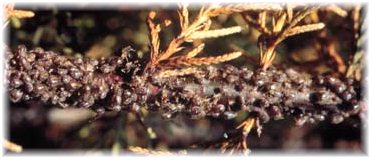Cypress canker (Seiridium cardinale)
Seiridium cardinale is a microscopic fungal parasite and pathogenous agent of a disease known as bark canker, which has already registered countless "victims" in Tuscany, many other parts of Italy and the Mediterranean basin. The characteristic symptoms of this disease are the presence on branches and tree trunks of sunken, deformed, cracked areas which ooze remarkable quantities of resin and which are known by the name "canker".
When the canker has completely enveloped the circumference of a twig or branch the part above dies and large, withered areas appear on the foliage. In the spring, little black pustules (acervuli) form on the cankers. These contain the reproductive organs of the parasite (conidi). These, spread by rainwater on the tree, cause new outbreaks of infection which, together with the old ones, produce even greater withered patches until the tree dies.
Some insects (coleotteri scolitidi) can also spread the infection by carrying it from the diseased trees to healthy ones, thus infecting them, during their biological cycle. The problem is based on quickly identifying the branches which are withering which always have the resinous area of the canker at their base. These branches are removed by cutting into the healthy area underneath the canker.
All the infected material is then collected and burned. If the canker is positioned too low on the trunk, cutting the diseased part could compromise the aesthetic appearance of the tree; in these cases (if the canker hasn't spread too much along the circumference) the infected area can be surgically removed (with a special operation) after which the scar is disinfected and protected with special rubber solutions. In the case of young plantations, and in particular nurseries, it is advisable to spray the foliage with chemical treatments containing benzimidazoles (benomyl and carbendazim) twice in the spring and once in the autumn.
It is advisable to use resistant clones which our institute has created as replacements for the dead trees. These are sold under the names of "Bolgheri" and "Agrimed n.1". The success of every effort is conditioned by the decontamination of the entire area which should be the result of active collaboration between public bodies and private owners until a regulation which allows diseased trees to be felled wherever they are situated is brought into force.
The cypress aphid (Cinara cupressi)
The sudden widespread withering of foliage which was observed at the end of this spring and beginning of the summer affecting the common cypress (Cupressus sempervirens) and the silver cypress (Cupressus arizonica and Cupressus glabra) is caused by colossal infestations of the aphid Cinara cupressi. The colonies (groups of aphids) settle on the bark of young lignified twigs creating a kind of sleeve. They feed by piercing the bark and sucking the sap. Unfortunately, the saliva they produce is phytotoxic and leads to necrosis in the phloem (conducting tissue of the sap) which subsequently results in the twig withering.

One of the aphid colonies which infest the cypresses
(photo Alberto Panconesi/C.N.R.)
The ants which feed on the honeydew (a sugary substance produced by the aphids) contribute to their diffusion by transferring them from one part of the tree to another, thus creating new areas of infestation. At the beginning of the summer, when the temperature rises and the infestation is at its height, the sap cannot get to its destination (the apex of the leaves) because of the necrosis of its conducting tissues.
Consequently, the ends of the twigs in some or all of the foliage sudden wither. As the weather gets hotter the aphids move down to the earth seeking protection from the summer heat. This is why at this point any form of treatment is useless, because when the first withered areas become visible the vast majority of the aphids are no longer on the foliage. The withered areas caused by the aphids are distinct from those caused by the canker because they occur more suddenly, are distributed more evenly, to the extent that the trees seem partially or totally burnt, and there is never any resin discharge. Sometimes, before the withered areas become visible, the branches turn a blackish colour known as "sooty mould"
This is caused when the honeydew is colonized by dark-coloured opportunistic funguses. The Cinara looks reasonably like what is commonly called the rose louse but is slightly bigger and darker. By looking carefully, the aphid colonies are visible to the naked eye and can sometimes be identified by following the paths of the ants. There are specific treatments to combat this aphid containing Pirimicarb (Pyrimor), a product which has a low toxic level for humans and other insects. For the treatments to succeed, they must target the first aphid colonies that settle on the tree after hibernation (this takes place by the month of March in Italy).
Later treatments are always less successful and are useless if carried out after the appearance of the withered areas (as we have already seen). The treatment depends on the presence of the aphid which can be detected by shaking the branches so that it falls onto a white cloth placed underneath the tree. The success of the treatment depends on spraying all the foliage, above all the internal branches. It is best to wait before felling even badly damaged trees because they can often recover through the growth of adventitious buds.
